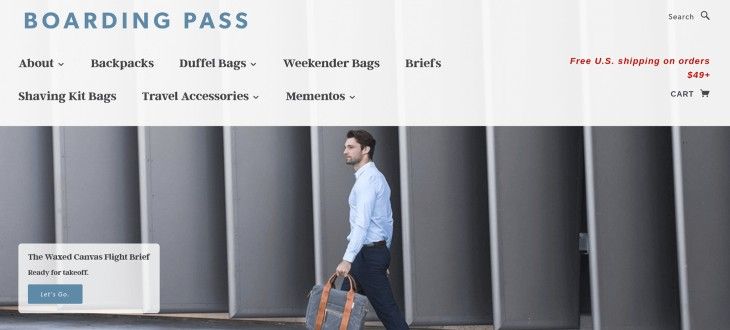How To Ask Customers For Reviews
Not every visit to your website leads to a purchase. Your analytics are proof of that. Converting visitors to customers remains one of the largest pain points among growing ecommerce retailers, next to generating targeted traffic.
For many retailers, getting customer reviews is a way to turn the tide and increase conversions (i.e. purchases) on your site.
Did you know only 17% of customers are actively browsing with the intent to purchase? Some customers aren’t ready to buy, and instead are:
- Browsing for a gift
- Adding something to a wish list
- Researching prices and options
- Window shopping out of pleasure or boredom
In many cases though, the customer simply doesn’t trust you. They do trust the social proof you can provide via customer reviews though.
BONUS: Before you read further, download our Warehouse Management Software Whitepaper to see how Logiwa uses real-time tracking to help customers get up to 100% inventory accuracy and increase shipments by 2.5x.
Contents
Customer Trust is Critical in eCommerce
More than likely, you can recall a recent purchase or a trip to a new restaurant where you checked reviews online before making a decision. That’s how today’s consumers shop. They’re looking for proof that a business, and its products, meet the needs of the customer.
Establishing trust lets you overcome one of the greatest barriers that prevents customers from buying from you. Without trust you’ll find it incredibly difficult to compete in eCommerce.
Trust in business (as well as media and government) have fallen to record lows. Consumers are wary of brand messaging and are far less likely to believe the hype and promises made by retailers and manufacturers.
As an online retailer, you face a real challenge since consumers never set foot in a store, never handle the product, and never see you in person. They’re sending a payment out in good faith to someone, somewhere, with the expectation that their products will arrive as promised.
For the longest time, people relied on referrals and recommendations from people they knew and trust. This is still the case; 83% of consumers place the greatest trust in people they know who have used or purchased the same product already.
eCommerce has expanded shopping to a global level, making it harder to find people we know who have purchased the same goods online.
That’s why more than 60% of consumers trust the reviews of strangers while shopping online.
The Benefits of Customer Reviews in eCommerce
Simply put, reviews lead to an increase in revenue. That happens as a result of trust and social proof.
Potential customers may not trust the word of an individual stranger, but when a lot of people say a product is amazing, then it’s perceived as amazing.
Likewise, if dozens of people (or more) say a product is inferior, then consumers will tend to trust the group consensus.
What is Social Proof?
Social proof is based on the idea of normative social influence; the idea that people conform in order to be liked, accepted by, or similar to a group.
According to Robert Cialdini, who detailed his studies of the principle of social proof in his book, Influence: The Psychology of Persuasion, “We view a behavior as more correct in a given situation to the degree that we see others performing it.”
Essentially, when we’re uncertain of what to do, we look to the people around us to make a more informed decision.
This theory is backed by several studies, like the Solomon Asch Conformity Experiment, which shows people are more likely to conform to the choice of the majority, even if the decision is clearly wrong.
With customer reviews, you’re borrowing the persuasion of your audience in order to build trust with new customers, ultimately making them feel comfortable enough to make a purchase.
But are reviews really effective?
Reviews Build Repeat Orders
Repeat orders make up 35% of Owen & Fred’s revenue, which is a level of customer retention many brands dream of. Because they invest so heavily in a customer-centric business model, their customers need no prompting to share their amazing experience.

Caption: Owen & Fred sells men’s duffel and weekend bags. Their customer experience has turned their customers into evangelists.
One compliment from a customer read: “never purchased from a company that actually delivered a product that amazing.”
Reviews Improve Organic Search Visibility
Google uses hundreds of ranking factors to determine where sites appear in its search results, and one of those factors are customer testimonials. A BigCommerce study revealed how 30,000 eCommerce brands were tested to see how customer reviews impacted search rank.
Over the course of a nine-month study, researchers found that retailers prominently featuring customer reviews saw a 45% increase in organic traffic on average.
Reviews Generate Business Growth
Every retailer wants to grow and expand their business. Leveraging customer reviews is one of the best ways to do that. One Harvard Business School study found that a one-star increase in your Yelp rating can lead to a 5-9% growth in sales for all types of business, regardless of niche.
Reviews Influence Purchase Decisions and Make Consumers Spend More
Consumer purchase decisions are heavily influenced by online reviews. 53% of 18-29 year old consumers read product reviews before making a purchase, and 40% of consumers will decide to make a purchase after only reading 1 – 3 online reviews.
Customers spend up to 31% more while shopping with a brand that has excellent reviews. Especially when those reviews directly relate to the product of interest. Likewise, for every star a business gets, there will be approximately a 5 – 9% increase in business revenue.
Reviews Improve Product Conversions Online
The simple act of having reviews featured prominently on your product pages can boost conversion rates, and the more reviews you have, the greater the chance of increasing your conversion rate.
According to data shared by Adweek:
- Just one review can boost conversions by 10 percent
- At 100 reviews, your conversion rate could be boosted by as much as 37 percent
- At 200 reviews, this rate could rise by a shocking 44 percent
How To Ask Customers For a Review
To make the most of reviews, you want to have as many of them as possible, whether they’re good, average, and even negative. But it’s not always easy to get customers to leave reviews. Unless there’s something to motivate them to take action, you’ll probably only see reviews from customers who were really blown away by your product or service.
For that reason, you have to learn how to ask customers for a review.
There’s no special way to phrase it and you don’t need flowery words. Just speak from the voice of your brand and ask for a review.
And you’re not limited in how you can ask for that review. To ensure you connect with the largest audience of customers, you’ll want to ask for reviews using a multi-channel strategy.
Follow Up Emails
One of the best times to ask for a review is shortly after the sale. By doing this, you can harness post-purchase momentum, when the interaction with your brand and the product is still fresh in your customers’ mind.
Most retailers already use automated email responders to trigger order confirmations. You can use email marketing solutions like Mailchimp or Klaviyo to add a follow-up email timed shortly after the product should arrive to your average customer.
Make sure it’s personalized to the customer and their purchase. This is a great opportunity to ask them to provide feedback on their experience. Give them the option to respond to you directly as well as leave a customer review.
Feature Your Customers
Building relationships with customers can go a long way toward developing social proof, building a community of loyal brand advocates, and generating more in-depth reviews. Aside from having standard product reviews on your site and brand reviews on social media, make a section of your site featuring your customers.
Customers are tired of sales pitches and brand messages, so serve them the voice of their peers with user generated content. Take some time each month to feature one or more of your customers.
Socialphotos is a great example of an app that curates customer generated content. Using Instagram, the Shopify plugin will pull photos of your customers using your products and put them in a gallery.
“User-generated content lets you shine a spotlight on your customers’ good experiences with your brand, which then piques shoppers’ interest and influences their behavior throughout the buyer journey,” says Neil Patel, expert marketer and co-founder of Kissmetrics and Quick Sprout.
When you feature customers, ask them to tell a success story revolving around your brand or product. You can also provide them with interview-style questions they can answer about themselves.
Brands have been using user generated content for years. The fashion industry is well known for using customer photos on Instagram and other visual platforms.
Take this to the next level with customer success stories.
Ask For Reviews on Social Media
You’re already engaging with your customers and followers on social media. Use that platform to encourage customers to leave you a review. While a dedicated post prompting followers to post a review may feel “desperate”, it’s anything but.
If you’re struggling to come right out and ask, then do it as part of another post. Share customer images, put up a product collage of a recent launch or a top-selling product, or share a success story.
As part of the post, ask customers if they’ve had a chance to review their latest purchase.
55% of consumers use Facebook as a place to learn about brands, making it a great social network to promote special offers.
Be sure to make leaving a product review as easy as possible for your customers. Instead of only posting a link back to your site, also encourage them to post reviews on other sites as well as on your social media accounts.
Include an Ask in the Packaging
You can add a message to your customer’s receipt or packing slip reminding them to stop by your site to review their purchase.
Better yet, catch your customer’s attention by including a small, colorful postcard with the packaging. Include a brief message thanking them for the purchase and asking them to come back and leave a customer review on your website.
Remember, it’s important to reduce friction and make it as easy as possible for them to follow through.
When you ask a customer for a review using a print card, include a custom short URL that takes them directly to your site for posting a review.
Send a Reminder Text
If you’re already sending marketing texts to your customers, then you have another route to ask them for a review. A few days after a shipment is delivered, send your customer an SMS message wishing them well, thanking them, and prompting them to come back and leave a review.
The benefits to an SMS message are it’s brief, requires no special design, and gets delivered immediately to the customer’s phone.
Timing is Everything When You Ask for Reviews
You may get some past customers who will come back to leave a review, but the longer you wait the harder it is to solicit that feedback and benefit from it. Once you decide how to ask a customer for a review, make sure you’re asking in stages.
Remind them after the purchase, follow up with a personalized email, and be sure to share testimonials and success stories alongside an ask on social media.
Studies have shown time and again the significant impact customer reviews can have on revenue and growth in eCommerce. Not only are most eCommerce platforms designed with reviews as a native feature, you can also find apps with expanded functionality to let you maximize the benefits of social proof.
In order to see those benefits, you have to connect with your customers and ask.
Related Terms
Tips by Logiwa during the COVID-19. Learn how Logiwa customers applied social distancing guidelines in their warehouses while increasing their business volume 12x.
How do you give your customers the best customer experience in peak season? Discover tips to give your customers a better experience with this guide.
Still not ready for peak season? Prepare for the challenges of the crazy shopping season with this guide.
Holiday Fulfillment Strategies
To cash in during the most lucrative time of year, make sure to take revamp your holiday order fulfillment strategy. Here are a few holiday fulfillment strategies to keep track of.
Supplier Relationship Management
Supplier relationship management can help improve your supply chain operations and overall success through coordination and collaboration. Learn more in this guide.
Mobilize everything to understand how your employees move and operate in your warehouse
Warehouse Management
Modern digital WMS powers a modern fulfillment experience
Inventory Management
Improve your inventory across your supply chain.






